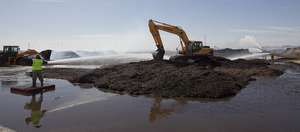$20 million for Turning Sludge into Compost
Published on by Water Network Research, Official research team of The Water Network in Business
Several years after a buildup of compost in Austin led to persistent fires, costing at least $3 million and taking more than a month to extinguish, city officials want to hire a waste hauler to cut down the amount of material piling up around its Hornsby Bend facility.
They blame the buildup on a downturn in the market for Dillo Dirt, the Austin-branded compost composed of sewage sludge and yard clippings. A half-dozen years ago, the city of Austin sold 45,000 cubic yards of Dillo Dirt for nearly $550,000 in revenue. Last year, sales were down by nearly two-thirds, city data show. City officials say the drought was to blame, as Austinites turned away from landscaping.
 The Austin City Council will consider in August a contract that will turn over much of the compost-making to an outside company. Eager to steer compostable material away from landfills, city officials say the deal will mean more compost and more sales. But environmental activists and a powerful landfill and compost company say the deal will lead to less composting. Environmentalists say the contract is a prelude to shipping more sludge to be spread on ranchland or farmland outside Austin, known as land application.
The Austin City Council will consider in August a contract that will turn over much of the compost-making to an outside company. Eager to steer compostable material away from landfills, city officials say the deal will mean more compost and more sales. But environmental activists and a powerful landfill and compost company say the deal will lead to less composting. Environmentalists say the contract is a prelude to shipping more sludge to be spread on ranchland or farmland outside Austin, known as land application.
Every day, city facilities treat about 90 million gallons of wastewater, separating about a million gallons of solids destined for the Hornsby Bend Biosolids Management facility. Eventually, the solids are broken down and disease organisms are killed by bacteria. Finally, the city is left with sludge, which it combines with branches and leaves picked up curbside to create Dillo Dirt.
 “Our goal is to keep our inventory low,” said Jane Burazer, assistant director for treatment at the Austin Water Utility. “We are trying to keep that lower to keep the risks and dangers down. If we could move it as Dillo Dirt, we would love to move it as Dillo Dirt, but we are not getting those sales.”
“Our goal is to keep our inventory low,” said Jane Burazer, assistant director for treatment at the Austin Water Utility. “We are trying to keep that lower to keep the risks and dangers down. If we could move it as Dillo Dirt, we would love to move it as Dillo Dirt, but we are not getting those sales.”
The city has been disposing of sludge through Dillo Dirt and by paying Baltimore-based Synagro to haul off the rest — to Eagle Lake, about 100 miles away, to be spread on ranchland.
“Ideally, we’d like to get where every single pound of biosolids goes out through some kind of composting method — that’s our goal,” Austin Water director Greg Meszaros told members of the city’s Water and Wastewater Commission this month. “It’s not to increase land application.”
A money loser
Dillo Dirt has run in the red in recent years: Last year, costs to produce Dillo Dirt edged over $650,000, while revenue amounted to about $205,000. Over the last five years, the program has typically lost between $400,000 and $500,000, according to information provided by Austin Water.
City officials said the 130- to 170-degree temperatures generated during the composting process kill pathogens. An Austin/Travis County Health and Human Services Department analysis found that Dillo Dirt poses no health risk even to people who accidentally ingest some.
Source: My Statesman
Media
Taxonomy
- Sludge Treatment
- Sludge Management
- Composting
1 Comment
-
The pathogens are easy to kill but they are only 1/20,millionth of the problem. Today's sludges, septages and even "Properly??" treated waste-waters contain millions of man-made, potentially, life altering/ threatening and extremely persistent, "durable" "nano-compounds" such as "cytotoxins", "nonylphenols", "glyphosate", "estradiol", muscle relaxers, mood changers, fire protectants, plastic softeners plus millions more. At the present time, there are no known sustainable, safe methods for permanently, removing/ de-constructing these compounds. Today, there are organizations that promote saving your human urine to be used for garden fertilizer. 50 years ago this would have been an excellent idea but in today's world our urine contains compounds and sub-compounds that we do not want introduced into the food chain. The re-use of sewage water for potable, laundry, shower water is extremely frightening. We stopped using all composted sludge and recycling graywater >20 years ago. Please send me your e-mail address if you would like scientific documentation on all of this. Al